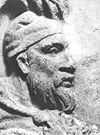- Cotiso
-
Cotiso (approximately 30 BC) was a Dacian king who ruled the mountains between Banat and Oltenia (modern-day Romania). Horatius calls him king of the Dacians[1]. Suetonius calls him king of the Getae [1]. He is mentioned also by Florus, who wrote that Cotiso and his armies used to attack towards south when the Danube froze.
After the death of Burebista, the Dacian kingdom fell apart amid turnoil and civil strife. Yet, the people of the Dacians now under king Cotiso found itself courted by the two Roman antagonists. Octavian / Augustus worried about the frontier and possible alliance between Mark Antony and the Dacians, and plotted an expedition around 35 BC. Because of Antony, he had to propose a marriage with the daughter of Cotiso. The war with Antony prevented his plan from completion, and no settlement of the Dacian question was forthcoming during Augustus's reign. Despite several small conflicts, no serious campaigns were mounted. Augustus claimed in his Res Gestae that the Dacians had been subdued. This was mere propaganda, because Dacian troops frequently crossed the Danube to ravage parts of Pannonia and Moesia[2].
According to Appian, Antony is responsible for the statement that Augustus sought to secure goodwilll of Cotiso, king of the Getae (Dacians) by giving him his daughter, and he himself marrying a daughter of Cotiso[3]. According to Suetonius, Cotiso refused the alliance and joined the party of Antony[4]. According to Dio, Antony's story to the proposed marriages is hardly credible and may have been invented by him to offset his own alliance with Cleopatra [4].
Suetonius (LXIII, Life of Augustus) says Marcus Antonius wrote that Augustus betrothed his daughter Julia to marry Cotiso (M. Antonius scribit primum eum Antonio filio suo despondisse Iuliam, dein Cotisoni Getarum regi) to create an alliance between the two men. This failed when Cotiso betrayed Augustus. Julia ended up marrying her cousin Marcus Claudius Marcellus. After Caesar Augustus's victory in the civil wars, the Romans punished the Dacian ruler, who was defeated by general Marcus Licinius Crassus. In an ode dedicated to his protector, Horatius advises him not to worry about Rome's safety, because Cotiso's army had perished.
Notes
- ^ a b John T. White, D.D. Oxon (1875) 70
- ^ Matthew Bunson (1995) 124
- ^ Translations and reprints from the original sources of history, Univ. of Pennsylvania Press, 1898 , University of Pennsylvania. Dept. of History
- ^ a b Monumentum ancyranum: the deeds of Augustus, Volume 5, Issue 2, Augustus (Emperor of Rome) The Department of history of the University of Pennsylvania, 1898, page 73
References
- John T. White, D.D. Oxon (1875) The first (-fourth) book of the Odes of Horace with a vocabulary and some accounts of Horatian metres, London
- Matthew Bunson (1995): A dictionary of the Roman Empire, Publisher: Oxford University Press, ISBN-10: 0195102339 ISBN-13: 978-0195102338
Dacia topics Dacian tribes: Aedi · Albocense · Anartes · Apuli · Artakioi · Biephi · Biessoi · Buri · Carpi · Cauci · Ciaginsi · Clariae · Costoboci · Cotini · Crobidae · Daci · Getae · Moesi · Osi · Peukini · Piephigi · Potulatense · Predasense · Rhadacense · Saldense · Scaugdae · Sense · Suci · Terizi · Teurisci · Trixae · Tyragetae · Troglodytae
Dacian kings: Culture and civilisation: Art, jewellery, treasures, tools (Bracelets) · Clothing · Foreign Relations (Greeks · Celts · Romans · Germanic tribes) · Warfare (Falx · Sica · Thracian warfare)
Sarmizegetusa · Argidava · Buridava · Cumidava · Piroboridava · Sucidava · More towns... · Davae · Dacian Fortresses of the Orăştie Mountains · Murus dacicusWars with the
Roman Empire:Roman Dacia: Dacia Traiana · Moesia · Scythia Minor · Dacia Aureliana · Diocese of Dacia · Dacia Mediterranea · Dacia Ripensis · Trajan (Bridge · Column) · Towns and cities · Castra · Limes (Alutanus · Moesiae · Porolissensis · Sarmatiae · Transalutanus · Trajan's Wall · Brazda lui Novac) · Language (Thraco-Roman · Eastern Romance substratum)Research on Dacia: Books on Dacia · Dacian archaeology · Archaeological sites in Romania · Dacology · Thracology · ProtochronismWikiProject • Commons • Dacian fortresses, settlements, Roman castra, limes from Romania: Google Maps • Google Earth Categories:- Dacian kings
Wikimedia Foundation. 2010.
